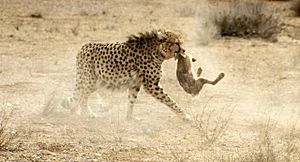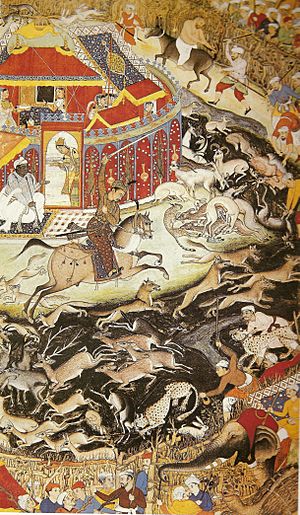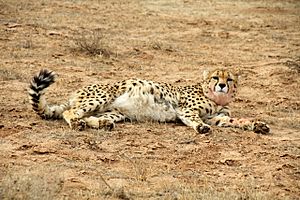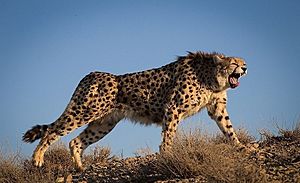Asiatic Cheetah facts for kids
Quick facts for kids Asiatic Cheetah |
|
|---|---|
 |
|
| Portrait of an Asiatic Cheetah from India | |
| Conservation status | |
| Scientific classification | |
| Kingdom: | |
| Phylum: | |
| Class: | |
| Order: | |
| Family: | |
| Genus: | |
| Species: | |
| Subspecies: |
A. j. venaticus
|
| Trinomial name | |
| Acinonyx jubatus venaticus (Griffith, 1821)
|
|
| Synonyms | |
|
Acinonyx jubatus raddei |
|
The Asiatic Cheetah (Acinonyx jubatus venaticus) is a special type of cheetah. It is also known as the Iranian Cheetah. This is because the only wild Asiatic cheetahs left in the world live in Iran.
Even though it is no longer found in India, it is sometimes called the Indian Cheetah. Long ago, during the time of British rule in India, it was known as the Hunting-Leopard. This name came about because some Indian rulers kept these cheetahs. They used them to hunt wild antelopes.
Contents
Amazing Cheetah Facts
The Asiatic cheetah has fur that is light brown or yellowish. It is paler on its sides, face, and inner legs. Small black spots are found on its head and neck in lines. On its body, legs, paws, and tail, the spots are scattered randomly. The tip of its tail has black stripes. Its fur and mane are shorter than those of cheetahs in Africa.
An adult Asiatic cheetah's body and head are about 112 to 135 centimeters (44 to 53 inches) long. Its tail adds another 66 to 84 centimeters (26 to 33 inches). These cheetahs usually weigh between 34 and 54 kilograms (75 to 119 pounds). Male cheetahs are a little bigger than females.
The cheetah is the fastest land animal on Earth! It can run incredibly fast. Scientists used to think that a cheetah's body got very hot during a chase. This was thought to be due to all the energy it used. However, studies in the wild show that their body temperature stays mostly the same. A cheetah might get a little warmer after a hunt because it feels stressed. This stress happens because other predators might try to steal its meal. Being stressed helps the cheetah be ready to run away if another animal comes near.
Where They Live
Asiatic cheetahs love open spaces. They live in plains, semi-desert areas, and other open habitats. These places must have enough prey for them to hunt. The Asiatic cheetah mainly lives in the desert areas around Dasht-e Kavir in eastern Iran. This includes parts of several provinces like Kerman and Khorasan.
Most of these cheetahs live in five special protected areas. These include Kavir National Park and Touran National Park.
In the 1970s, there were about 200 Asiatic cheetahs in Iran. They lived in 11 protected areas. By the late 1990s, their numbers had dropped a lot. There were only about 50 to 100 cheetahs left.
Between 2001 and 2012, researchers used camera traps to count the cheetahs. They found 82 individual cheetahs in 15 to 17 families. Sadly, 42 cheetahs died during this time. Some were hunted illegally, some died in road accidents, and others from natural causes. The groups of cheetahs are now spread out. They are known to live in several provinces, including Semnan and Yazd.
How They Live
Cheetahs in the Miandasht Wildlife Refuge are often seen during the day. They are usually near water sources. This suggests they are most active when their prey is also active.
Studies from 2009 to 2011 show that some cheetahs travel very long distances. One female cheetah was seen in two protected areas. These areas were about 150 kilometers (93 miles) apart. There was a railway and two highways between them. Her three brothers and another male cheetah were seen in three different reserves. This means they need large areas to roam.
What They Eat

The Asiatic cheetah hunts medium-sized plant-eating animals. These include chinkara (a type of gazelle), goitered gazelle, wild sheep, wild goat, and cape hare. In Khar Turan National Park, cheetahs use many different habitats. But they prefer areas close to water. These areas often have wild sheep, onagers (wild donkeys), and gazelles.
In India, there used to be many animals for cheetahs to hunt. Before they disappeared from India, cheetahs ate animals like the blackbuck and chinkara. Sometimes, they also hunted chital (a type of deer) and nilgai (a large antelope).
Raising Cubs

It is very rare to see female cheetahs successfully raising their cubs in the wild. A few times, observations in Iran have shown that they give birth throughout the year. They usually have one to four cubs. In April 2003, four cubs were found in a den. Their eyes were still closed. In November 2004, a camera trap recorded a cub that was about 6 to 8 months old.
For cheetahs to have many cubs, there needs to be enough prey for them to eat. In October 2013, a female with four cubs was filmed in Khar Turan National Park. In December 2014, four cheetahs were seen and photographed by camera traps in the same park. In January 2015, three other adult Asiatic cheetahs and a female with her cub were seen in Miandasht Wildlife Refuge. More cheetahs were spotted in the following months. In July 2015, five adult cheetahs and three cubs were seen in Khar Turan National Park.
Dangers They Face

The Asiatic cheetah has been listed as Critically Endangered since 1996. This means they are at a very high risk of disappearing forever. After the Iranian Revolution in 1979, efforts to protect wildlife stopped for a few years. Military exercises happened in the steppes, and people hunted cheetahs and their prey without rules. The number of gazelles went down in many areas. This made cheetahs move to remote mountain habitats.
Many things have caused the cheetah population to shrink. These include fewer gazelles, illegal hunting, changes in land use, and their habitats becoming smaller and broken up. The cheetahs are also affected when their prey is hunted too much. Also, too many farm animals grazing in their areas push out the cheetahs' food. One time, a herder chased a female cheetah and her two cubs on his motorbike. One cub got so tired it collapsed. The herder caught it and kept it chained at his home for two weeks. Luckily, wildlife officers rescued it.
Mining and building roads near protected areas also threaten the cheetahs. Coal, copper, and iron have been mined in cheetah habitats in central and eastern Iran. Even though mining itself doesn't directly harm the cheetahs, the new roads and traffic make it easier for people, including poachers, to reach them.
Helping Them Survive

In September 2001, a project called "Conservation of the Asiatic Cheetah and its Associated Biota" began. The Iranian Department of Environment worked with many groups, including the United Nations Development Programme and the Wildlife Conservation Society. Their goal is to protect the Asiatic cheetah.
In February 2007, experts started putting radio collars on Asiatic cheetahs. These collars use GPS to track the cats' movements. This helps researchers learn more about them. Sometimes, getting equipment like camera traps has been hard due to international rules.
Some orphaned cheetah cubs have been raised by humans. One such cub was Marita, who lived to be nine years old. After she died in 2003, August 31st became Cheetah Conservation Day. This day helps teach people about protecting cheetahs.
In 2014, the Iran national football team put pictures of the Asiatic cheetah on their soccer uniforms. This was to help bring attention to conservation efforts. In February 2015, Iran launched a search engine called Yooz, which has a cheetah as its logo. In May 2015, the Iranian Department of Environment announced that the fine for illegally hunting a cheetah would be much higher. It went up to 100 million tomans (about US$2500 in 2022). In September 2015, Meraj Airlines put a new Iranian Cheetah design on their planes to support conservation. Iranian officials have also talked about building special crossings for wildlife. This would help reduce the number of cheetahs killed in traffic accidents.
Related pages
Images for kids
See also
 In Spanish: Guepardo asiático para niños
In Spanish: Guepardo asiático para niños





